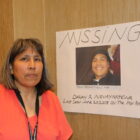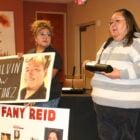Indigenous Affairs
Controversial Indian Affairs secretary leaving agency
|
This reporting was supported by the International Women’s Media Foundation’s Fund for Indigenous Journalists: Reporting on Missing and Murdered Indigenous Women, Girls, Two Spirit and Transgender People (MMIWG2T). After a tumultuous tenure as Indian Affairs Secretary-designate, James Mountain is departing the agency to join Gov. Michelle Lujan Grisham’s office as her senior policy advisor for tribal affairs, her spokeswoman announced Friday. Deputy Secretary Josett Monette will replace Mountain as Indian Affairs cabinet secretary.
Mountain’s departure comes about 10 months after several members of a state task force on missing and murdered Indigenous people — housed in the Indian Affairs Department — denounced his appointment. Since then, the governor has steadfastly rebuffed demands from task force members and some state lawmakers to replace Mountain.It was unclear why Mountain departed and whose decision it was: Mountain’s or the governor’s. Cabinet secretaries serve at the pleasure of the governor.









